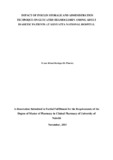| dc.contributor.author | Kedogo, Evans K | |
| dc.date.accessioned | 2016-04-22T05:59:30Z | |
| dc.date.available | 2016-04-22T05:59:30Z | |
| dc.date.issued | 2015-11 | |
| dc.identifier.uri | http://hdl.handle.net/11295/94729 | |
| dc.description.abstract | Background: Insulin therapy is the mainstay of treatment for type I diabetes and also adjunct therapy for some type 2 diabetic patients. Proper storage and self-administration of insulin play an important role in long term optimal blood sugar control. There is scant published literature on diabetes self-care practices on insulin administration, handling and storage, and their impact on the overall glycemic control as measured by glycated hemoglobin. Study objective: To assess the impact of insulin administration techniques and handling on the levels of glycated hemoglobin among diabetic patients at Kenyatta National Hospital. Study population: Diabetes mellitus patients of aged 18 years and above refilling monthly insulin prescriptions in Kenyatta National Hospital. Methodology: A tertiary hospital based cross-sectional study was used to consecutively sample 73 diabetic patients on insulin. Insulin storage and administration techniques were assessed using a pre-designed questionnaire. Overall control of blood glucose was determined by measurement of serum concentrations of glycated haemoglobin. Association between insulin storage methods, insulin administration technique and level of diabetes control was determined using Pearson’s Chi square test at p-value of 0.05. Results: The mean age of the participants was 53.6 (±11.0) years. The median age was 52.0 years (range 25-75). Majority of the participants were female at 63.0%. Slightly over 90 % had been on insulin for over 6 months. Almost all patients had been trained on insulin storage and injection techniques but only 30 % had been assessed on them. None of the patients was able to perform all the steps of injection technique. In addition, none of the patients knew that insulin should be discarded after 28 days of opening. Correct performance of the critical injection steps was associated with good glycemic control (p=0.013). However, refrigeration of insulin was not statistically associated with good glycemic control (p= 0.062). Conclusion and Recommendation Assessment of insulin use by patients in the hospital is inadequate. Good insulin injection technique is associated with optimal glycemic control unlike storage by refrigeration. We recommend regular and continuous patient training and assessment on insulin injection technique to improve glycemic control at Kenyatta National Hospital. | en_US |
| dc.language.iso | en | en_US |
| dc.publisher | University of Nairobi | en_US |
| dc.subject | Diabetes management | en_US |
| dc.title | Impact of insulin storage and administration technique on glycated heamoglobin among adult diabetic patients at Kenyatta National Hospital | en_US |
| dc.type | Thesis | en_US |
| dc.description.department | a
Department of Psychiatry, University of Nairobi, ; bDepartment of Mental Health, School of Medicine,
Moi University, Eldoret, Kenya | |

